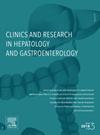CT-quantified visceral fat and risk of gallbladder stones in Korean men: A cross-sectional study of 2939 cases
IF 2.4
4区 医学
Q2 GASTROENTEROLOGY & HEPATOLOGY
Clinics and research in hepatology and gastroenterology
Pub Date : 2025-08-12
DOI:10.1016/j.clinre.2025.102670
引用次数: 0
Abstract
Background
Gallbladder (GB) stones are a common gastrointestinal disorder influenced by metabolic and lifestyle factors. Visceral adiposity has been proposed as a key contributor to GB stone pathogenesis, but evidence using direct quantification of visceral fat in men is limited. This study aimed to investigate the association between visceral fat area, measured by abdominal pelvic computed tomography (CT), and the prevalence of GB stones in Korean men.
Methods
In this retrospective cross-sectional study, 2939 Korean men who underwent abdominal pelvic CT and ultrasonography during routine health examinations were included. Visceral and subcutaneous fat areas were quantified at the L3 vertebral level using CT images. Participants were categorized into quartiles based on fat area. Logistic regression models assessed the relationship between fat distribution and GB stone prevalence, adjusting for demographic, clinical, lifestyle, and biochemical factors.
Results
The mean age was 52.4 ± 9.6 years. The prevalence of GB stones increased significantly with higher visceral fat quartiles (p=0.010), while no significant trend was observed with subcutaneous fat. In the fully adjusted model, men in the highest visceral fat quartile had more than twice the odds of having GB stones compared to those in the lowest quartile (OR 2.108, 95 % CI 1.014–4.385, p=0.046), while subcutaneous fat showed no significant association.
Conclusions
Increased visceral fat, rather than subcutaneous fat, is independently associated with the presence of GB stones in Korean men. These findings highlight visceral adiposity as a significant risk factor for GB stone formation and suggest that incorporating visceral fat assessment could enhance risk stratification and early identification of individuals at risk.
ct量化的韩国男性内脏脂肪和胆囊结石风险:2939例横断面研究
背景:胆囊结石是一种常见的受代谢和生活方式影响的胃肠道疾病。内脏脂肪被认为是GB结石发病的关键因素,但直接量化男性内脏脂肪的证据有限。本研究旨在探讨韩国男性腹部骨盆计算机断层扫描(CT)测量的内脏脂肪面积与GB结石患病率之间的关系。方法:在这项回顾性横断面研究中,包括2,939名在常规健康检查中接受腹部盆腔CT和超声检查的韩国男性。使用CT图像在L3椎体水平量化内脏和皮下脂肪区域。参与者根据脂肪面积被分为四分位数。Logistic回归模型评估了脂肪分布与GB结石患病率之间的关系,并对人口统计学、临床、生活方式和生化因素进行了调整。结果:患者平均年龄52.4±9.6岁。随着内脏脂肪四分位数的增加,GB结石的患病率显著增加(p=0.010),而皮下脂肪的增加无显著趋势。在完全调整后的模型中,内脏脂肪含量最高的四分位数男性患GB结石的几率是最低四分位数男性的两倍多(OR 2.108, 95% CI 1.014-4.385, p=0.046),而皮下脂肪含量没有显著相关性。结论:在韩国男性中,内脏脂肪而非皮下脂肪的增加与GB结石的存在独立相关。这些发现强调了内脏脂肪是GB结石形成的重要危险因素,并表明结合内脏脂肪评估可以加强风险分层和早期识别高危个体。
本文章由计算机程序翻译,如有差异,请以英文原文为准。
求助全文
约1分钟内获得全文
求助全文
来源期刊

Clinics and research in hepatology and gastroenterology
GASTROENTEROLOGY & HEPATOLOGY-
CiteScore
4.30
自引率
3.70%
发文量
198
审稿时长
42 days
期刊介绍:
Clinics and Research in Hepatology and Gastroenterology publishes high-quality original research papers in the field of hepatology and gastroenterology. The editors put the accent on rapid communication of new research and clinical developments and so called "hot topic" issues. Following a clear Editorial line, besides original articles and case reports, each issue features editorials, commentaries and reviews. The journal encourages research and discussion between all those involved in the specialty on an international level. All articles are peer reviewed by international experts, the articles in press are online and indexed in the international databases (Current Contents, Pubmed, Scopus, Science Direct).
Clinics and Research in Hepatology and Gastroenterology is a subscription journal (with optional open access), which allows you to publish your research without any cost to you (unless you proactively chose the open access option). Your article will be available to all researchers around the globe whose institution has a subscription to the journal.
 求助内容:
求助内容: 应助结果提醒方式:
应助结果提醒方式:


